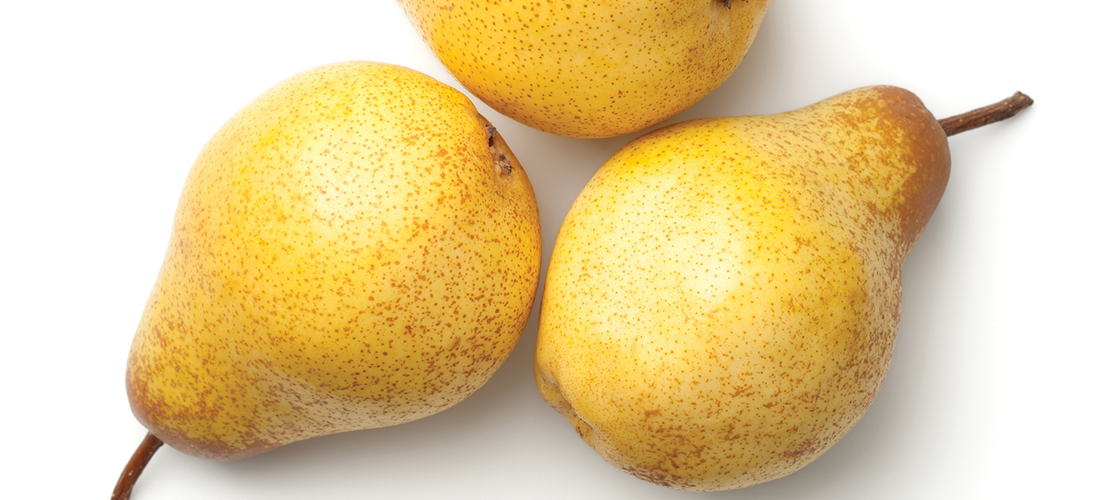
September Pears
Yard decoration or just plain delicious
By Jan Leitschuh
Tough to grow on a commercial basis, local Sandhills homeowners can still enjoy home-grown pears and spring bloom in their landscapes.
Now is the harvest season for pears, so get ready to enjoy this sweet fall fruit, whether you’ve grown it or purchased it at the grocery as prices drop.
The cute little “Honeysweet” pear tree I planted six years ago has at least half a dozen little pears on it this year. Way to amortize a $50 investment, eh? That’s about $6 a pear, this year.
In the Honeysweet’s defense, it has borne a few good fruits in the last few years, and is planted in a very hot, dry and sandy section of the property — so props for even surviving, much less bearing sweet little treats. It adds pretty spring blossoms to our edible landscape and keeps a trim size, so the sweet treats are a bonus. Let’s see your crabapple or dogwood do all that.
In North Carolina, pears are not a big commercial crop, mostly due to the disease called “fire blight,” a bacterial withering many pear varieties are susceptible to. The affected young tips look as if they were blasted with a flame-thrower. The browned ends curl into a characteristic “shepherd’s hook” shape. If you do find fresh pears at roadside stands, it will likely be more toward the mountains in apple-growing areas.
But a homeowner without a financial stake can plant a decorative, blight-resistant tree or two and reap the benefits in good years, as well as enjoy the lovely spring bloom.
The other pear issue is their tendency to bloom early and get whacked by a late hard frost. This is a disaster for a commercial operation, but a homeowner can toss a quilt over a small tree, or find other temporary means to keep the cold night temperatures at bay, removing the covers in the morning so the bees can pollinate the blossoms.
Pears are one of the world’s best known and favored fruits. And while a homeowner can plant a pear tree or two for successful fun — our Southern Pines neighbor has a very prolific bearer — the good news is that the supermarkets are full of the seasonal fruit right now, and for the next few months.
My husband and I love to combine two fruits that peak about now. Come the end of August and into September we love to pick our backyard figs and simmer them with pears and a little lemon juice into a delectable pear/fig sauce we then freeze in little tubs and serve all fall with pork chops, or on sweet potatoes. The leftover pears go into salads with different creamy cheeses, or into a pear crumble.
So even if the little Honeysweet fails, we have plenty of backup for our favorite annual fruit sauce, fresh eating, pear tarts and salads — and so do you. Beautiful varieties such as Anjou (red and green), Bosc (an artistic tan), Seckel (the “sugar” pear), Bartlett, Comice and more — your favorite market will have them on special this month as the harvests in California and the Northwest come in.
Let’s say you want to try your hand at a little edible landscaping. Your best bet is to plant a fire blight-resistant variety. There are several. The old Kieffer variety gives a pretty reliable harvest. (I’ve noticed several homes in the Sandhills with Kieffer pear trees.) The fruit is a bit coarse, and not the smooth quality of the highly fire blight-susceptible Bartlett, but I’ve eaten it fresh and it makes a great pear/fig sauce, as well as jams, preserves and canning. Also look for newer, more blight-tolerant varieties such as Moonglow and Magness. The teeny but quite delicious Seckel variety is also somewhat fire blight resistant and puts out lots of fruits, ripening in late August.
New varieties are being released and might be worth an experiment. Some North Carolina folks give up on conventional pears and plant the fairly blight-resistant Asian pear, enjoying its unusual apple-like crunch. You can buy these in stores now, too, to decide if you like them.
Luckily, the Sandhills has a few pluses for kitchen-garden pear production, even if our humidity and dew encourage fire blight. Cold air flows downhill, so a higher Sandhills site might offer better frost protection and airflow than at the bottom of a slope. Our deep sandy soils make the pear’s vigorous root system happy. They don’t like a tight clay. Like apples, they detest “wet feet,” poorly drained sites. Plant your tree in November and water well. Don’t use fertilizer in the hole, as it will burn roots.
High nitrogen fertilizers are also a no-no, since that encourages rapid growth of the juicy green new growth so susceptible to fire blight. Simple compost or a low nitrogen fertilizer should do the trick. Google fire blight to recognize the browned tips, and prune them off well into healthy tissue, dipping your clippers in alcohol after each cut to avoid spreading the bacteria. Also, keep the weed eater away from the sprouts that form at the base of a pear — prune those in winter. Follow simple shaping advice. It’s easy to find it online. Whatever you do, don’t whack your tree back to prune it. The vigorous root system will send up useless, vertical shoots from every branch. Prune judiciously.
Pear-picking timing is a little different from many fruit harvests. Pears should be harvested when fully formed, but not ripe. If you have a tree with fruit, start looking closely in early August.
When to actually pick a pear takes some trial and error. The size and shape should look like a ripe pear, and the pear’s color should have a slight yellow undertone. The squeezing texture morphs slightly from rock-hard to just firm, and it should pick easily, twisting off. Don’t be afraid to pick a few to experiment with and make a mistake because the changes are subtle.
After picking, refrigerate your pears for a couple of days. You can also hold them for a while at this stage in the vegetable crisper of your fridge. To ripen them, remove and let stand four or five days at room temperature. Once you have a feel for your particular variety, you can chill pears and ripen them at your convenience.
Or, get thee to a supermarket pear special
this month.
Fall Balsamic Pear Salad with Walnuts and Gorgonzola
Balsamic Vinaigrette:
1/3 cup extra virgin olive oil
2 1/2 tablespoons balsamic vinegar
1 tablespoon honey
1 teaspoon Dijon mustard
1 1/2 tablespoons finely diced shallot
Salt and freshly ground black pepper to taste.
Salad:
2 pears, ripe, sliced thin
Lettuce/spinach blend
1/2 cup chopped walnuts (candied optional)
2 ounces Gorgonzola or other blue cheese, crumbled
(Optional: sprinkling of dried sweetened cherries or cranberries)
Whisk up the dressing. Slice ripe pears shortly before serving to avoid browning. Layer salad and pears. Top with walnuts, cheese and more pears (and dried fruit, if desired). Drizzle with dressing just before serving. PS
Jan Leitschuh is a local gardener, avid eater of fresh produce and co-founder of the Sandhills Farm to Table cooperative.





